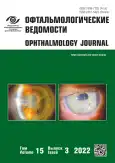Случаи поражения слёзного аппарата после перенесённой коронавирусной инфекции
- Авторы: Белдовская Н.Ю.1, Аникина Л.К.1, Ангелопуло Г.В.1, Морозюк А.1
-
Учреждения:
- Первый Санкт-Петербургский государственный медицинский университет им. акад. И.П. Павлова
- Выпуск: Том 15, № 3 (2022)
- Страницы: 91-100
- Раздел: Клинические случаи
- URL: https://journals.rcsi.science/ov/article/view/131580
- DOI: https://doi.org/10.17816/OV111169
- ID: 131580
Цитировать
Аннотация
В работе рассмотрены случаи развития патологии слёзного аппарата после перенесённой новой коронавирусной инфекции COVID-19. Цель — определить причины появления эпифоры у пациентов, перенёсших коронавирусную инфекцию.
Обследованы 26 человек (30 глаз) в возрасте от 28 до 70 лет, предъявлявших жалобы на слезотечение, впервые возникшее не ранее 5–14 дней от начала заболевания лабораторно подтвержденной коронавирусной инфекцией COVID-19, протекавшей в лёгкой или средней степени тяжести и сопровождавшейся аносмией. У 22 пациентов выявлена патология горизонтального отдела слёзных путей; у 6 человек установлен диагноз синдрома сухого глаза: у 3 человек — лёгкой степени и у 3 человек — средней степени тяжести. В качестве сопутствующих изменений у 7 пациентов обнаружена ринологическая патология, у 2 человек выявлялась неврологическая симптоматика.
В обследованной нами группе пациентов с эпифорой через 1,5–3 мес. после перенесённой ими коронавирусной инфекции COVID-19 с аносмией, в качестве общего симптома заболевания, более чем в половине случаев была диагностирована патология горизонтального отдела слезоотводящих путей.
Полный текст
Открыть статью на сайте журналаОб авторах
Наталия Юрьевна Белдовская
Первый Санкт-Петербургский государственный медицинский университет им. акад. И.П. Павлова
Email: beldovskay@mail.ru
ORCID iD: 0000-0001-9864-504X
SPIN-код: 8331-1449
канд. мед. наук, доцент кафедры офтальмологии с клиникой им. проф. Ю.С. Астахова
Россия, Санкт-ПетербургЛилия Камилевна Аникина
Первый Санкт-Петербургский государственный медицинский университет им. акад. И.П. Павлова
Автор, ответственный за переписку.
Email: lily-sai@yandex.ru
ORCID iD: 0000-0001-8794-0457
SPIN-код: 3359-4587
аспирантка
Россия, Санкт-ПетербургГалина Владимировна Ангелопуло
Первый Санкт-Петербургский государственный медицинский университет им. акад. И.П. Павлова
Email: nmaculova@yandex.ru
канд. мед. наук, доцент кафедры офтальмологии с клиникой им. проф. Ю.С. Астахова
Россия, Санкт-ПетербургАнна Морозюк
Первый Санкт-Петербургский государственный медицинский университет им. акад. И.П. Павлова
Email: ana.moroziuk@gmail.com
ORCID iD: 0000-0002-2082-3341
SPIN-код: 7506-6597
аспирант кафедры офтальмологии с клиникой им. проф. Ю.С. Астахова
Россия, Санкт-ПетербургСписок литературы
- Yaguchi S., Ogawa Y., Shimmura S., et al. Presence and physiologic function of the renin-angiotensin system in mouse lacrimal gland // Invest Ophthalmol Vis Sci. 2012. Vol. 53, No. 9. P. 5416–5425. doi: 10.1167/iovs.12-9891
- Giese M.J., Speth R.C. The ocular renin-angiotensin system: a therapeutic target for the treatment of ocular disease // Pharmacol Ther. 2014. Vol. 142, No. 1. P. 11–32. doi: 10.1016/j.pharmthera.2013.11.002
- Vaajanen A., Kalesnykas G., Vapaatalo H., Uusitalo H. The expression of Mas-receptor of the renin-angiotensin system in the human eye // Graefes Arch Clin Exp Ophthalmol. 2015. Vol. 253, No. 7. P. 1053–1059. doi: 10.1007/s00417-015-2952-z
- Тургель В.А., Антонов В.А., Тульцева С.Н., и др. COVID-19 как новый фактор риска развития острых сосудистых заболеваний зрительного нерва и сетчатки // Офтальмологические ведомости. 2021. Т. 14, № 2. C. 105–115. doi: 10.17816/OV64115
- www.who.int [Электронный ресурс]. Основные сведения о COVID-19. Доступ по ссылке: https://www.who.int/ru/news-room/questions-and-answers/item/coronaviruse-disease-covid-19
- Бржеский В.В., Коникова О.А., Садовникова Н.Н., Ефимова Е.Л. Изменения органа зрения у детей и взрослых на фоне COVID-19 и противоэпидемических мероприятий // Российская детская офтальмология. 2021. № 3. С. 44–53. doi: 10.25276/2307-6658-2021-3-44-53
- Chen L., Liu M., Zhang Z., et al. Ocular manifestations of a hospitalised patient with confirmed 2019 novel coronavirus disease // Br J Ophthalmol. 2020. Vol. 104, No. 6. P. 748–751. doi: 10.1136/bjophthalmol-2020–316304
- Khavandi S., Tabibzadeh E., Naderan M., Shoar S. Corona virus disease-19 (COVID-19) presenting as conjunctivitis: atypically high-risk during a pandemic // Cont Lens Anterior Eye. 2020. Vol. 43, No. 3. P. 211–212. doi: 10.1016/j.clae.2020.04.010
- Майчук Д.Ю., Атлас С.Н., Лошкарева А.О. Глазные проявления коронавирусной инфекции COVID-19 (клиническое наблюдение) // Вестник офтальмологии. 2020. Т. 136, № 4. С. 118–123. doi: 10.17116/oftalma202013604111
- Meduri A., Oliverio G.W., Mancuso G., et al. Ocular surface manifestation of COVID-19 and tear film analysis // Sci Rep. 2020. Vol. 10, No. 1. ID 20178. doi: 10.1038/s41598-020-77194-9
- Cheema M., Aghazadeh H., Nazarali S., et al. Keratoconjunctivitis as the initial medical presentation of the novel coronavirus disease 2019 (COVID-19) // Can J Ophthalmol. 2020. Vol. 55, No. 4. P. e125–129. doi: 10.1016/j.jcjo.2020.03.003
- Guo D., Xia J., Wang Y., et al. Relapsing viral keratoconjunctivitis in COVID-19: A case report // Virol J. 2020. Vol. 17. ID 97. doi: 10.1186/s12985-020-01370-6
- Lan Q.Q., Zeng S.M., Liao X. [A special on epidemic prevention and control: screening for novel coronavirus related conjunctivitis among the patients with coronavirus disease 2019] // Zhonghua Yan Ke Za Zhi. 2020. Vol. 56, No. 6. P. 433–437. [In Chinese] doi: 10.3760/cma.j.cn112142-20200322-00213
- Martínez Díaz M., Copete Piqueras S., Blanco Marchite C., Vahdani K. Acute dacryoadenitis in a patient with SARS-CoV-2 infection // Orbit. 2021. Vol. 41, No. 3. P. 374–377. doi: 10.1080/01676830.2020.1867193
- Sen M., Honavar S.G., Sharma N., Sachdev M.S. COVID-19 and Eye: A Review of Ophthalmic Manifestations of COVID-19 // Indian J Ophthalmol. 2021. Vol. 69, No. 3. P. 488–509. doi: 10.4103/ijo.IJO_297_21
- Нероев В.В., Кричевская Г.И., Балацкая Н.В. COVID-19 и проблемы офтальмологии // Российский офтальмологический журнал. 2020. Т. 13, № 4. С. 99–104. doi: 10.21516/2072-0076-2020-13-4-99-104
- Al-Namaeh M. COVID-19 and conjunctivitis: a meta-analysis // Ther Adv Ophthalmol. 2021. Vol. 13. ID 25158414211003368. doi: 10.1177/25158414211003368
- Бржеский В.В., Сомов Е.Е. Синдром сухого глаза. Санкт-Петербург: Аполлон, 1998. 96 с.
- Hu Y., Chen T., Liu M., et al. Positive detection of SARS-CoV-2 combined HSV1 and HHV6B virus nucleic acid in tear and conjunctival secretions of a non-conjunctivitis COVID-19 patient with obstruction of common lacrimal duct // Acta Ophthalmol. 2020. Vol. 98, No. 8. P. 859–863. doi: 10.1111/aos.14456
Дополнительные файлы













